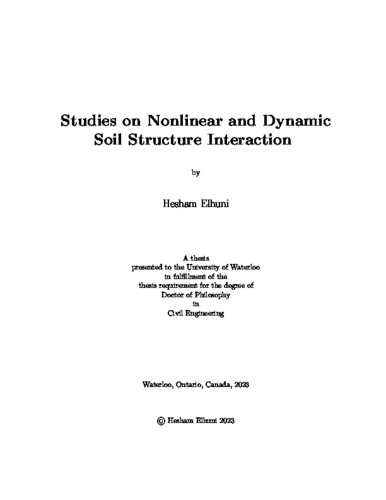| dc.description.abstract | High-speed trains, excessive loads in moving trucks, and vibrating machines on foundations on soft ground can generate significant vibration and deformation in the subgrade (soil). Better understanding and realistic analysis of the interaction between railway tracks, pavements, and foundations and the supporting soil under moving and dynamic loads is necessary. Experimental investigations are always associated with large costs when simulating the loading conditions. Modeling dynamic soil-structure interaction problems is often associated with a high level of complexity and a large computational effort.
Analytical modeling of these problems that results in accurate and reliable prediction of these soil structure interaction problems with a low computational cost and ease of use is a distinct advantage that can supplement the numerical modeling and experimental investigations.
In this research, a new computationally efficient but mathematically rigorous semianalytical continuum model is developed for dynamic analysis of beams resting on layered poroelastic nonlinear soil deposit and subjected to dynamic loads. The proposed model is developed in stages in terms of the complexity of simulating the soil behaviour. First, the soil is simulated as a discrete two-parameter foundation in which the soil body is represented by mechanical springs with shear interactions. Subsequently, the soil is simulated as a linear and nonlinear continuum. Finally, the soil is simulated as a linear and nonlinear poroelastic continuum, For the continuum-based analysis, a simplified continuum approach was adopted in which the soil displacement field is expressed as a product of separable variables. The principle of virtual work was applied to obtain the governing
differential equations that were solved partly analytically and partly numerically. The
semi-analytical approach was found to be significantly faster than the corresponding full
blown finite element analysis.
A significant contribution of this work is the simulation of the nonlinear and poroelastic
response of soil in the semi-analytical framework, which otherwise require elaborate
meshing by the users and high computational effort. A nonlinear hyperbolic stress-strain
relationship is used to represent the soil nonlinearity. Biot’s poroelastic theory is used
to represent the poroelastic behaviour of soil. The nonlinear dynamic, nonlinear consolidation,
and nonlinear poroelastic dynamic responses of the beams under moving and
oscillating loads are obtained. It is envisaged that the methods developed in this thesis
will provide more insights into the dynamic soil structure interaction problem, and will
help in developing design aids. | en |

